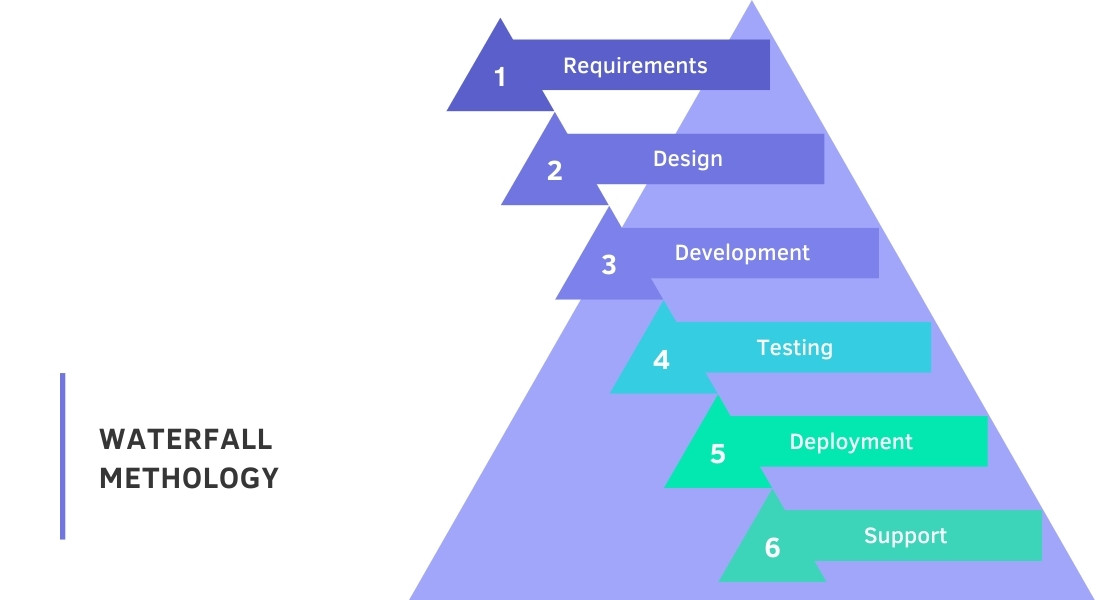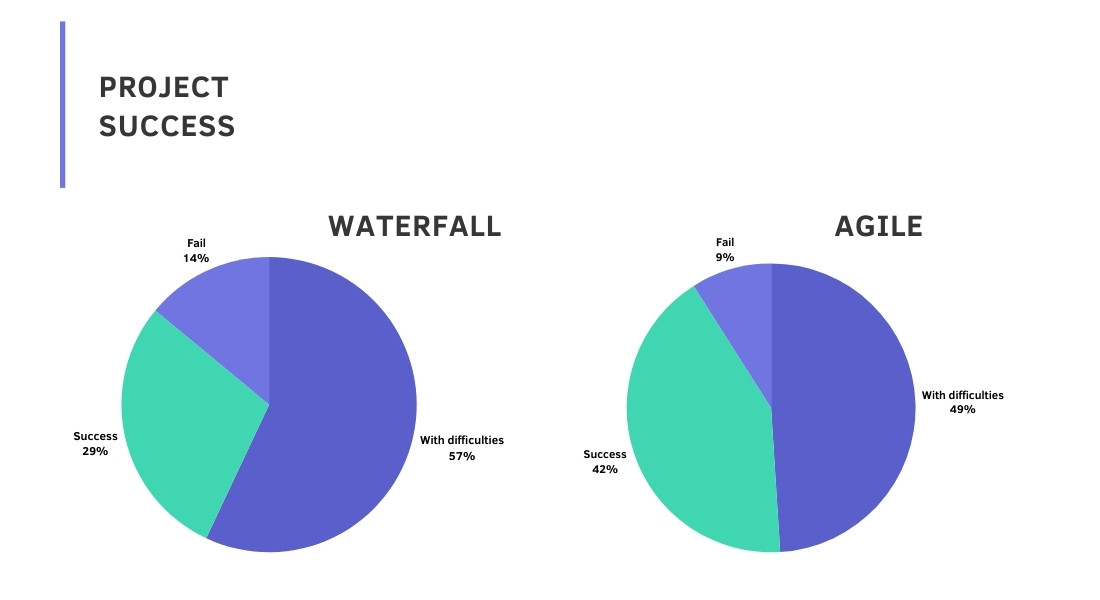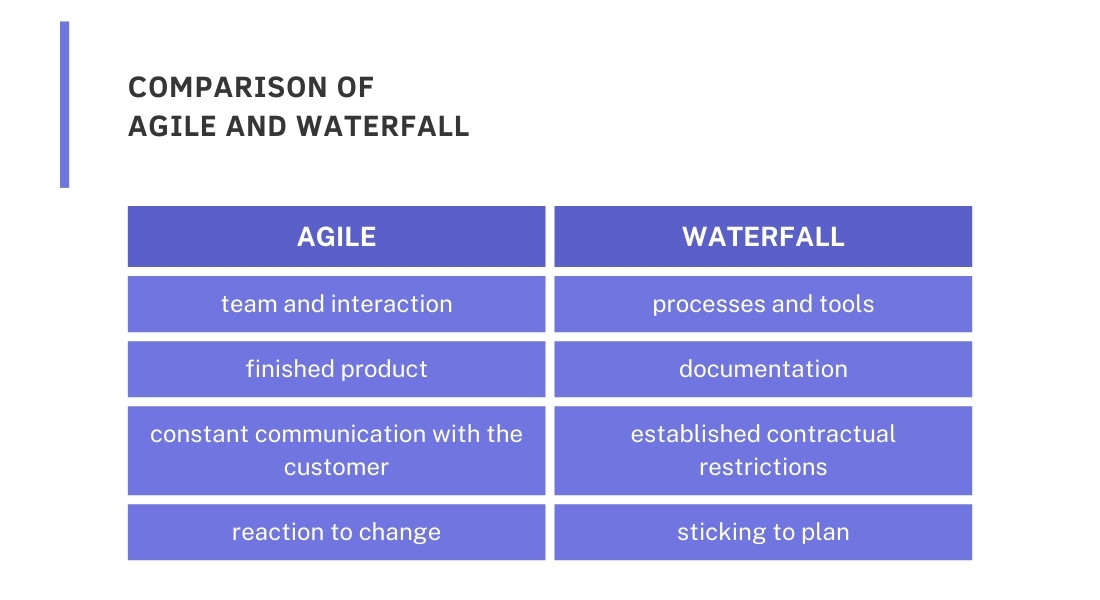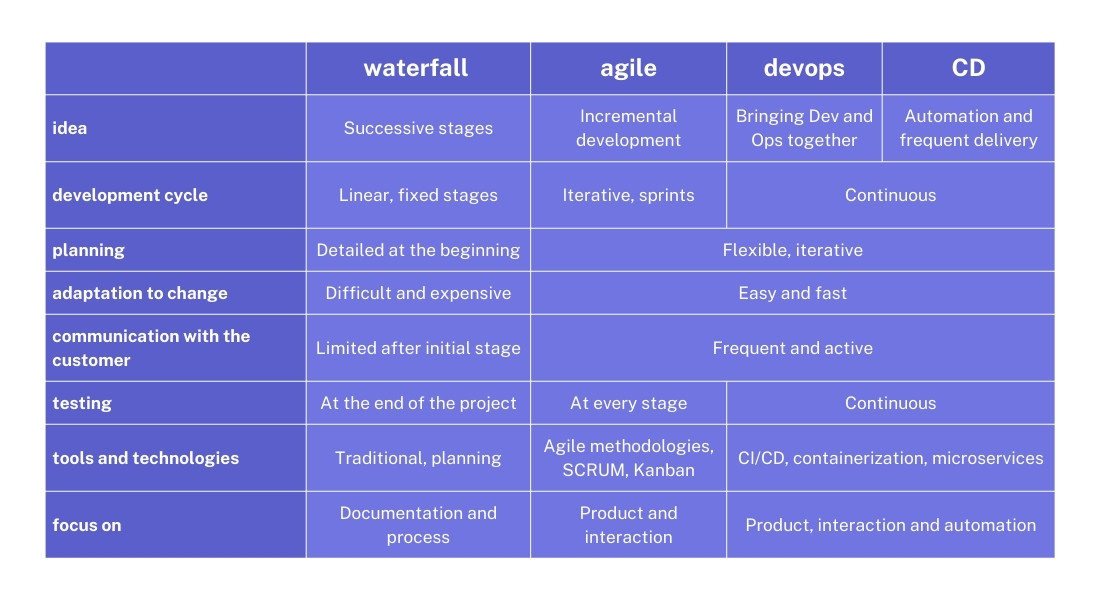Software development methods have undergone significant changes in recent decades. There has been a transition from the traditional waterfall model to more flexible and adaptive methodologies (Agile, DevOps, CD). This transition made it possible to create higher quality products in the shortest possible time. Do you know what catalyzed these changes and why Waterfall is considered obsolete? Let’s figure it out together.
What is Waterfall? Classic Model in Modern Realities
Waterfall, or the waterfall development model, is one of the earliest and most famous software development management methodologies.
In the early 1970s, the IT development industry was relatively young and rapidly growing. Projects became more complex and there was a pressing need for a streamlined and structured approach to their development and management.
At the same time, linear models were widely used in engineering and production. The developers borrowed experience from other areas and created a new concept – the Waterfall approach. Another argument for its creation at that time was the convenience of tracking progress and predicting results. A clear division into stages and milestones helped make the result more manageable and predictable, which was especially important for large and complex projects.
The main feature of the waterfall approach is the fixed sequence of development stages.

Main stages of Waterfall
- Specification preparation
It all starts with an accurate and detailed description of all functional and non-functional requirements in the spec. - Design
Once the requirements have been agreed upon, the design phase begins. It is divided into 2 levels: high-level design (creating the overall architecture of the system) and detailed design (defining all components of the system and their interactions). At this stage, architectural diagrams, UML diagrams and other design documents are created. - Development
Previously compiled design documentation is used by the development team to write code. The goal of this phase is to create a working version of the software that meets all requirements and design specifications. - Testing
After completing the development phase, the system undergoes comprehensive product testing in order to identify and correct all errors. This is necessary to ensure that the system works correctly and meets the requirements before it is released to end users. - Implementation
When the system has passed the testing stage successfully, everything is ready for implementation in the production environment. Implementation includes software installation, environment setup, and user training. - Support and Maintenance
After implementation, the system support and maintenance stage begins. The development team fixes errors that were identified by users or not taken into account by testers. Also, regular updates are carried out.
Benefits of Waterfall
- Structurality
Clearly defined steps and their sequence ensure transparency in the development process. Each team knows its tasks and deadlines for their completion. - Specification
Detailed documentation at each stage helps in future maintenance and scaling of the system. It also simplifies the process of project transfer between teams. - Ease of operation
Clear milestones and milestones allow managers to easily track progress and manage risks thanks to a pre-planned structure. - Planning
Ability to plan all resources, deadlines and budget of the project.
Disadvantages of Waterfall
- The model is poorly adapted to changes in requirements. Any change at later stages may require a review of the entire system.
- Errors made at the initial stages can only be detected at the testing stage, which increases the cost of correcting them.
- All stages must be completed sequentially, delaying the release of the product.
- The possibility of incorrect or inaccurate approval of requirements, which leads to a discrepancy with customer expectations for the final product.
When to use Waterfall?
Despite its limitations, Waterfall is still used by some teams and shows good results:
- Waterfall is quite applicable when the requirements for the system are clear and it is unlikely that they will change during the development process.
- In industries that require strict standards and certification (eg medical, aviation), Waterfall provides the necessary documentation and a high level of control.
- For small projects with limited resources, Waterfall may make more sense than agile methodologies that require complex management processes.

Only 29% of Waterfall projects are completed successfully without experiencing problems, while with the Agile philosophy this figure increases to 42%. Although waterfall is still used, Agile has a higher success rate. Only 9% of Agile projects fail, and a whopping 14% in waterfall.
Transition to Agile: flexibility and adaptability
With increasing demands for speed and quality of software release, it has become clear that Waterfall is a severely limited management option, especially for rapidly scaling teams or MNCs. In the early 2000s, the Agile methodology emerged, bringing with it a new philosophy of software development. Agile focuses on continuous interaction with the customer, rapid adaptation to change and gradual delivery of the product.
Agile differs from Waterfall primarily in its values. Agile focuses on flexibility and customer feedback, so priorities can change significantly as a project grows.
The main idea of Agile is an iterative and incremental approach to development, which allows teams to respond faster to changing requirements and interact more effectively with the customer. The Agile methodology is based on the Agile Manifesto, which includes four core values:
- People and interactions are more important than processes and tools.
- A working product is more important than comprehensive documentation.
- Cooperation with the customer is more important than agreeing on the terms of the contract.
- Being prepared to change is more important than sticking to the original plan.
To realize these values, Agile uses a number of methodologies and practices such as Scrum, Kanban and Extreme Programming (XP). Each of these methods has its own characteristics, but they all adhere to the basic principles of Agile:
- Development is carried out in short iterations (sprints), each of which lasts from one to four weeks. At the end of each iteration, the team presents a working product or part of it, which allows them to receive feedback from the customer and, if necessary, make changes in the next sprint.
- Regular meetings with the customer and demonstration of intermediate results allow you to better understand his needs and expectations, as well as quickly respond to changes.
- In Agile, a team consists of different specialists (developers, testers, analysts) who work together. This promotes team spirit and knowledge sharing within the team.
- Agile teams have a high degree of independence and responsibility for results. They themselves determine how best to complete tasks and organize their work.
- Retrospectives are held regularly to continually adjust and improve the work process.
According to statistics, since 2002, the use of Agile has increased by 88%.
What is incremental development?
Incremental development is a gradual increase in the functionality of a product. Each increment is an improvement or addition of a new feature. In the context of DevOps, incremental development is supported by continuous delivery (CD), which enables automated deployment of tested code to environments. This allows you to quickly and safely introduce new features and improvements, minimizing risks and ensuring system stability.

Read more about the Agile philosophy in the article What is Agile? Brief overview of methodologies.
Let’s talk about the connection between Agile and DevOps. Both methodologies are aimed at speeding up the software development and delivery process, increasing product quality, and improving collaboration between teams.
DevOps, as a broader concept, focuses on integrating and automating processes between developers and engineers, allowing for updates to be released more efficiently and quickly.
The Rise of DevOps: Merging Development and Operations
DevOps (short for Development and Operations) has emerged as the next stage in the evolution of development methodologies. DevOps is the integration and automation of processes between development and operation, allowing you to speed up the release of a product and improve its quality.
The approach arose from a desire to eliminate the traditional gaps in collaboration between developers and operations teams that led to missed deadlines, conflicts, and poor quality products.
Basic principles of DevOps
- Collaborative culture
Developers and engineers work together at all stages of the project, which allows them to better understand each other’s needs and tasks. Close communication reduces misunderstandings and disagreements within the team, increasing overall productivity and speeding up processes. - Automation of all processes
- Continuous Integration and Continuous Delivery (CI/CD)
Automation of the process of code integration and its deployment in various environments (testing, production, etc.). - Infrastructure automation
Using Ansible, Puppet or Terraform to automate IT infrastructure management. These tools reduce the system’s dependence on the human factor and increase the scalability and repeatability of processes. - Monitoring and logging
To improve the reliability of systems, their condition is constantly monitored, logs are collected to analyze performance and quickly detect problems.
Integrating Agile and DevOps allows teams to achieve better results in software development. Agile provides flexibility and adaptability, allowing the team to quickly respond to changing requirements and receive regular feedback from the customer. DevOps, in turn, ensures a continuous process of integration and delivery.
An example of successful integration of Agile and DevOps can be seen in the practice of Continuous Integration/Continuous Deployment (CI/CD). In Agile, the team works in short iterations, regularly introducing new features or product improvements. DevOps automates the process of building, testing, and deploying these changes, allowing the team to quickly and safely release new versions of the product. This reduces the risk associated with releasing large updates and allows you to respond more quickly to user feedback.
Continuous Delivery: The Most Modern Approach to Development Management
Continuous Delivery is a logical continuation of DevOps. A methodology that enables teams to continuously and reliably deploy software to any environment. The main goal of CD is to make deployment so simple and routine that the team can release updates at a moment’s notice.
And finally, two basic principles of CD: the entire process from writing code to its deployment should be automated, and changes made to the code should be ready for deployment at any time.
Advantages of CD
- Ability to release changes to production faster and more frequently;
- Smaller and more frequent updates reduce risks by separating them, thereby making change management easier;
- Constant testing and monitoring ensure high quality of the final software.
Disadvantages of CD
- A reliable and scalable infrastructure is required to automate processes;
- Successful CD implementation is impossible without a mature DevOps culture in the team;
- Automating deployment requires strict security controls.
